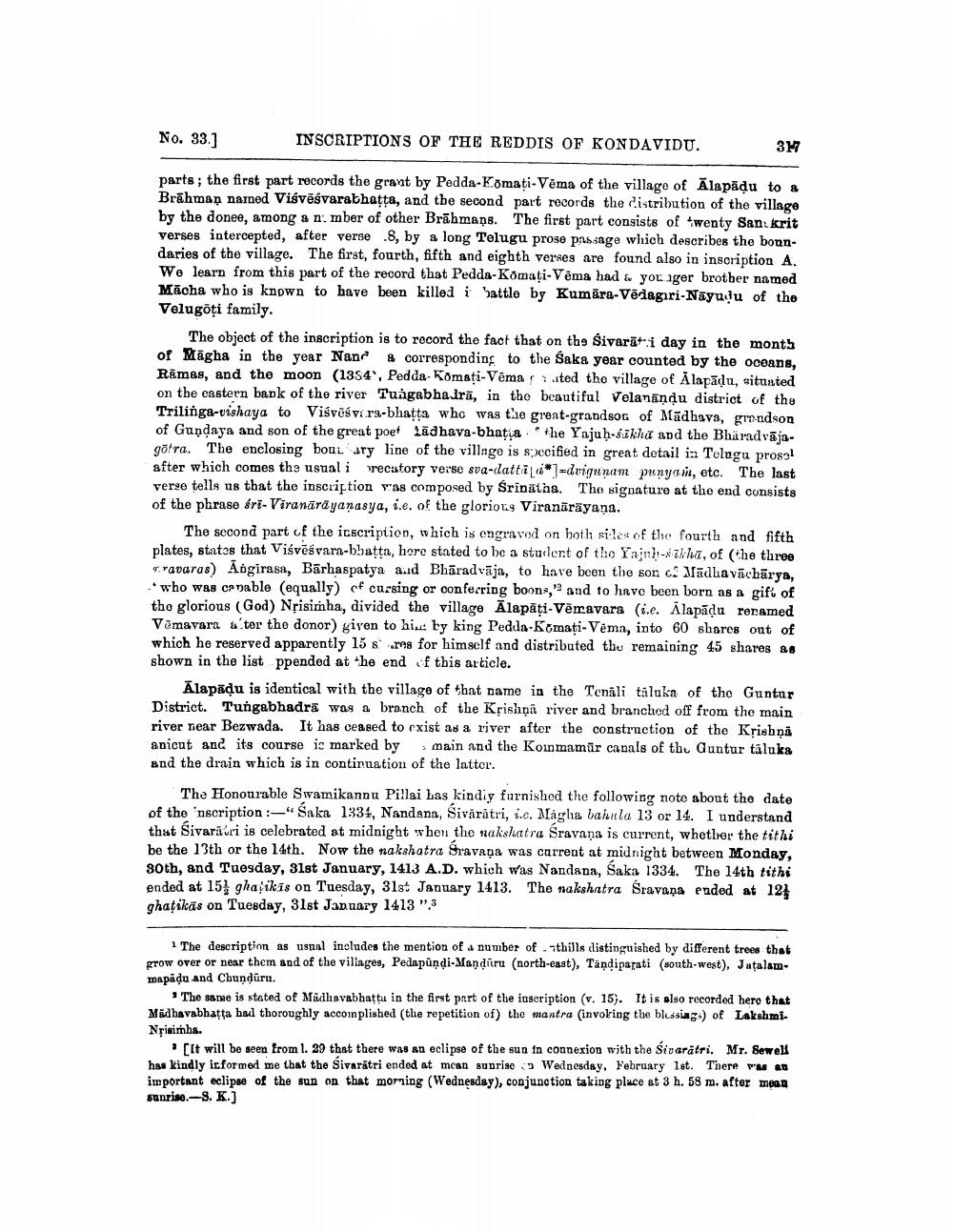________________
No. 33.]
INSCRIPTIONS OF THE REDDIS OF KONDAVIDU.
parts; the first part records the grant by Pedda-Komați-Vêma of the village of Alapäḍu to a Brahman named Visvesvarabhaṭṭa, and the second part records the distribution of the village by the donee, among a n. mber of other Brahmans. The first part consists of twenty Sankrit verses intercepted, after verse 8, by a long Telugu prose passage which describes the boundaries of the village. The first, fourth, fifth and eighth verses are found also in inscription A. We learn from this part of the record that Pedda-Komați-Vēma had & you ager brother named Macha who is known to have been killed i battle by Kumara-Vedagiri-Nayudu of the Velugoti family.
317
The object of the inscription is to record the fact that on the Sivarati day in the month of Magha in the year Nan a corresponding to the Saka year counted by the oceans, Rāmas, and the moon (1354, Pedda Komați-Vēmated the village of Alapadu, situated on the eastern bank of the river Tungabhadra, in the beautiful Velanandu district of the Trilinga-vishaya to Visvesvara-bhaṭṭa who was the great-grandson of Madhava, grandson of Gundaya and son of the great poet Ladhava-bhatia the Yajuḥ-sakha and the Bhärad vājagötra. The enclosing bou ary line of the village is specified in great detail in Telugu prosol after which comes the usual i recatory verse sva-datti Li*]-dvigunam punyam, etc. The last verse tells us that the inscription was composed by Srinatha. The signature at the end consists of the phrase éri-Viranarayanasya, i.e. of the glorious Viranārāyaṇa.
12
The second part of the inscription, which is engraved on both sides of the fourth and fifth plates, states that Visvesvara-bhatta, here stated to be a student of the Yajnh-kha, of (the three Travaras) Angirasa, Barhaspatya ad Bharadvaja, to have been the son c2 Madhavacharya, who was capable (equally) of cursing or conferring boons, and to have been born as a gift of the glorious (God) Nrisimha, divided the village Alapați-Vemavara (i.e. Alapadu renamed Vamavara a ter the donor) given to his by king Pedda-Komați-Vêma, into 60 shares out of which he reserved apparently 15 s res for himself and distributed the remaining 45 shares as shown in the list ppended at the end of this article.
Alapadu is identical with the village of that name in the Tenali taluka of the Guntur District. Tungabhadra was a branch of the Krishna river and branched off from the main river near Bezwada. It has ceased to exist as a river after the construction of the Krishna anicut and its course is marked by main and the Kommamur canals of the Guntur tāluka and the drain which is in continuation of the latter.
The Honourable Swamikannu Pillai has kindiy furnished the following note about the date of the 'nscription:"Saka 1334, Nandana, Śivaratri, i.c. Magha bahula 13 or 14. I understand that Sivaratri is celebrated at midnight when the nakshatra Sravana is current, whether the tithi be the 13th or the 14th. Now the nakshatra Sravana was current at midnight between Monday, 30th, and Tuesday, 31st January, 1413 A.D. which was Nandana, Saka 1334. The 14th tithi ended at 15 ghatikis on Tuesday, 31st January 1413. The nakshatra Sravana ended at 12 ghatikas on Tuesday, 31st January 1413 "3
1 The description as usual includes the mention of a number of "thills distinguished by different trees that grow over or near them and of the villages, Pedapündi-Mandiru (north-east), Tandiparati (south-west), Jatalammapadu and Chundūru.
The same is stated of Madhavabhatta in the first part of the inscription (v. 15). It is also recorded here that Madhavabhaṭṭa had thoroughly accomplished (the repetition of) the mantra (invoking the blessings) of LakshmiNrisimha.
[It will be seen from 1. 29 that there was an eclipse of the sun in connexion with the Śivaratri. Mr. Sewell has kindly informed me that the Sivaratri ended at mean sunrise Wednesday, February 1st. There was an important eclipse of the sun on that morning (Wednesday), conjunction taking place at 3 h. 58 m. after mean sunrise.-S. K.]




